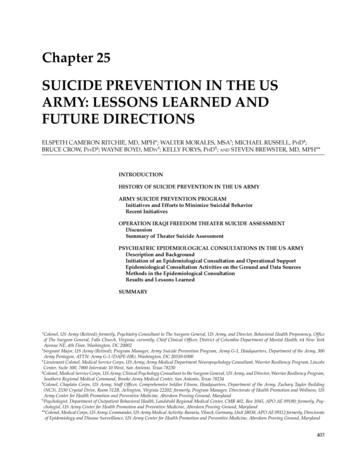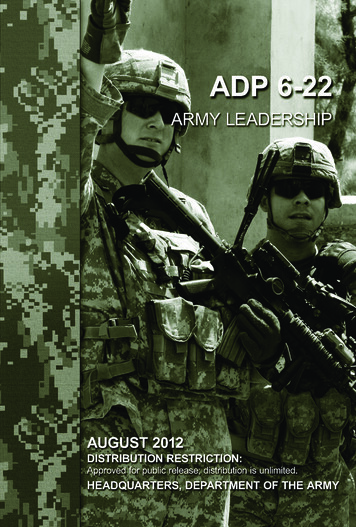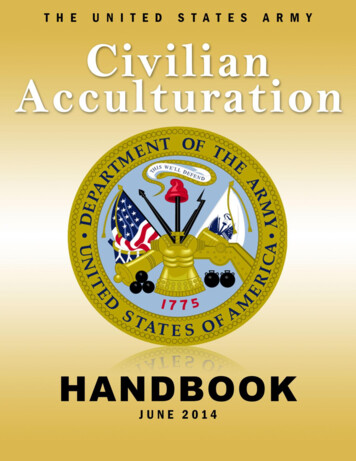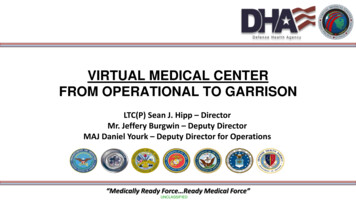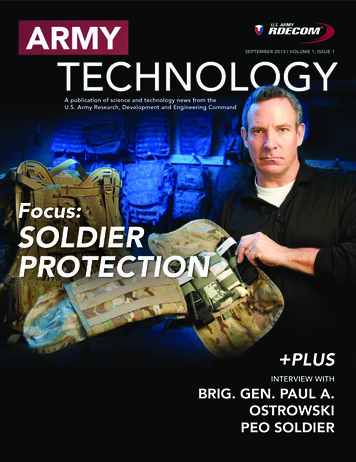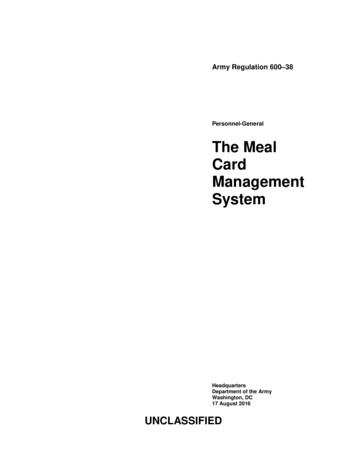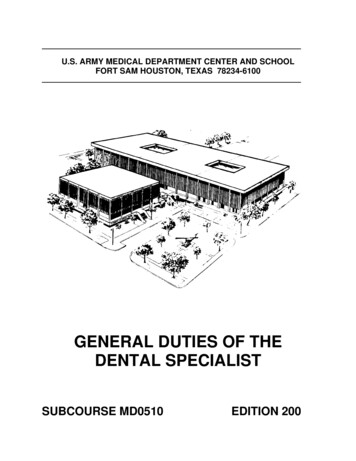
Transcription
U.S. ARMY MEDICAL DEPARTMENT CENTER AND SCHOOLFORT SAM HOUSTON, TEXAS 78234-6100GENERAL DUTIES OF THEDENTAL SPECIALISTSUBCOURSE MD0510EDITION 200
DEVELOPMENTThis subcourse is approved for resident and correspondence course instruction. Itreflects the current thought of the Academy of Health Sciences and conforms to printedDepartment of the Army doctrine as closely as currently possible. Development andprogress render such doctrine continuously subject to change.ADMINISTRATIONStudents who desire credit hours for this correspondence subcourse must enroll in the subcourse.Application for enrollment should be made at the Internet website: http://www.atrrs.army.mil. Youcan access the course catalog in the upper right corner. Enter School Code 555 for medicalcorrespondence courses. Copy down the course number and title. To apply for enrollment,return to the main ATRRS screen and scroll down the right side for ATRRS Channels.Click on SELF DEVELOPMENT to open the application; then follow the on-screen instructions.For comments or questions regarding enrollment, student records, or shipments,contact the Nonresident Instruction Section at DSN 471-5877, commercial (210) 2215877, toll-free 1-800-344-2380; fax: 210-221-4012 or DSN 471-4012, e-mailaccp@amedd.army.mil, or write to:NONRESIDENT INSTRUCTION BRANCHAMEDDC&SATTN MCCS HSN2105 11TH STREET SUITE 4192FORT SAM HOUSTON TX 78234-5064Be sure your social security number is on all correspondence sent to the Academy ofHealth Sciences.CLARIFICATION OF TRAINING LITERATURE TERMINOLOGYWhen used in this publication, words such as "he," "him," "his," and "men" are intendedto include both the masculine and feminine genders, unless specifically stated otherwiseor when obvious in context.USE OF PROPRIETARY NAMESThe initial letters of the names of some products are capitalized in this subcourse. Suchnames are proprietary names, that is, brand names or trademarks. Proprietary nameshave been used in this subcourse only to make it a more effective learning aid. The useof any name, proprietary or otherwise, should not be interpreted as an endorsement,deprecation, or criticism of a product; nor should such use be considered to interpret thevalidity of proprietary rights in a name, whether it is registered or not.
TABLE OF CONTENTSLessonParagraphsINTRODUCTION1THE ARMY DENTAL CARE SYSTEM. 1-1--1-3Exercises2SUPPORT DUTIES OF THE DENTAL SPECIALISTSection I.Section II.Section III.Supply and Supply Procedures. 2-1--2-15Laboratory Procedures . 2-16--2-17Administrative Functions . 2-18--2-23Exercises3CLINICAL DUTIES OF THE DENTAL SPECIALISTSection I.Section II.Section III.Section IV.Clinical Role . 3-1--3-2Patient Relationship . 3-3--3-9Assisting the Dental Officer. 3-10--3-12Clinic Routine. 3-13--3-17Exercises4THE TEAM APPROACH. 4-1--4-6ExercisesMD0510i
CORRESPONDENCE COURSE OF THEU.S. ARMY MEDICAL DEPARTMENT CENTER AND SCHOOLSUBCOURSE MED510GENERAL DUTIES OF THE DENTAL SPECIALISTINTRODUCTIONDental specialists are assigned as assistants to dental officers with duties varyingaccording to the section of the dental service in which they work. The duties of dentalspecialists may include the following: assisting dental officers in treating patients;instructing patients in oral hygiene; keeping dental appointments and office records;preparing dental records, including dental charts, under the direction of dental officers;preparing routine and special reports and forms; requisitioning, establishing, andmaintaining stock levels of supplies; maintaining supply records; performing supplyinventories; controlling and accounting for precious metals and narcotics; performingpreventive maintenance on dental equipment; and maintaining order and cleanliness ofdental treatment areas.The purpose of this subcourse is to provide you with a general knowledge of theduties of personnel assisting dental officers in the dental clinic, to include various typesof supply responsibilities and administrative duties, guidelines for patient relationship,routine responsibilities occurring on a daily or periodic basis, minor maintenanceresponsibility, and an overview of the branches of dentistry.Subcourse Components:This subcourse consists of four lessons. The lessons are as follows:Lesson 1, The Army Dental Care System.Lesson 2, Support Duties of the Dental Specialist.Lesson 3, Clinical Duties of the Dental Specialist.Lesson 4, The Team Approach.Credit Awarded:To receive credit hours, you must be officially enrolled and complete anexamination furnished by the Nonresident Instruction Section at Fort Sam Houston,Texas. Upon successful completion of the examination for this subcourse, you will beawarded 8 credit hours.You can enroll by going to the web site http://atrrs.army.mil and enrolling under"Self Development" (School Code 555).A listing of correspondence courses and subcourses available through theNonresident Instruction Section is found in Chapter 4 of DA Pamphlet 350-59, ArmyCorrespondence Course Program Catalog. The DA PAM is available at the followingwebsite: 510ii
LESSON ASSIGNMENTLESSON 1The Army Dental Care System.LESSON ASSIGNMENTParagraphs 1-1 through 1-3.LESSON OBJECTIVESAfter completing this lesson, you should be able to:SUGGESTIONMD05101-1.Identify the parameters of the Army Dental CareSystem.1-2.Identify the 10 branches of dentistry.1-3.Identify the role of the dental specialist withinthe dental care system.After studying the assignment, complete the exercisesat the end of this lesson. These exercises will help youto achieve the lesson objectives.1-1
LESSON 1THE ARMY DENTAL CARE SYSTEM1-1.GENERALThe Army Dental Care System is composed of officers of the Dental Corps,selected officers of the Medical Service Corps (MS), assigned enlisted personnel in themilitary occupational specialty (MOS) of 91E Dental Specialist, Additional Skill Identifier(ASI) N5—Dental Laboratory Specialist, ASI X2—Preventive Dentistry Specialist, andcivilian personnel. Civilian personnel include civilian dentists, chair-side dentalassistants, dental hygienists, expanded functions dental assistants (EFDAs), andadministrative personnel. The capabilities of the Army Dental Care System areenhanced at some installations by volunteer workers under the Red Cross VolunteerWorker Program. The Dental Corps is composed exclusively of commissioned officerswho are qualified doctors of dental medicine (DMD) or of dental surgery (DDS). Allprofessional phases of the practice of dentistry are performed by these dental officers.The mission of the Army Medical Department (AMEDD) is to maintain the health of theArmy and to conserve its fighting strength. Since oral disease and/or injury can producecasualties, the attainment and maintenance of oral health is an essential element of theAMEDD mission. The Army Dental Care System is charged with the diagnosis,prevention, and treatment of oral diseases, injuries, and deficiencies among militarypersonnel and, in certain areas, dental care of family members, retired militarypersonnel, and Department of the Army (DA) civilians.1-2.BRANCHES OF DENTISTRYDentistry is the branch of medical science and art concerned with the prevention,diagnosis, and treatment of diseases of the teeth and adjacent tissues. It is alsoconcerned with the restoration of defective and missing tissues. As dentistry hasadvanced, its practice has become increasingly complex with the evolvement of manyspecialties within the profession. This specialization is evident in the functionalorganization of the professional branch of Army dental clinics. The degree to whichsuch organization is established depends mostly upon the size of the clinic, the mission,and the availability of personnel. A typical dental clinic consists of oral examination anddiagnosis service (oral medicine), preventive dentistry, operative dentistry, oral surgery,and prosthodontics. Depending upon the mission and the personnel available, the clinicmay also include periodontal, endodontic, pedodontic, orthodontic, and oral pathologyservices.a. Oral Examination and Diagnosis Service. This branch of dentistry includesthe examination and evaluation of the patient's oral region and general health status. Italso includes the establishment of the proper sequence of any needed treatment.MD05101-2
b. Preventive Dentistry. This branch of dentistry is concerned with theprevention of oral disease or deformities and the complications from the conditionswhich develop. In most dental clinics, preventive dentistry includes patient education inoral hygiene, nutrition, oral pathology, and the need for regular professionalexaminations.c. Operative Dentistry. This branch of dentistry is concerned with therestoration of diseased or damaged teeth to health and function by the placement ofmetallic and nonmetallic restorations. It accounts for the greatest portion of clinicalprocedures accomplished.d. Oral Surgery. This branch of dentistry involves the diagnosis and thesurgical and adjunctive treatment of diseases, injuries, and defects of the jaws andassociated structures.e. Prosthodontics. This branch of dentistry involves the restoration andmaintenance of oral function through the replacement of missing teeth and structures bya prosthesis. Prosthodontics is divided into "fixed" and "removable." Removableprosthodontics includes maxillofacial prosthodontics, which is the art and science of thefabrication and replacement of missing parts of the oral-facial complex. A fixedprosthesis is an appliance, such as a crown or bridge, which is generally cemented inplace. It cannot be easily removed by either the patient or the dentist. A removableprosthesis is an appliance, such as a complete or partial denture, that can be removedand reinserted at the will of the patient.f. Periodontics. This branch of dentistry is concerned with the prevention,diagnosis, and treatment of diseases of the periodontium, which includes the gingiva,periodontal ligament, alveolar bone, and cementum of the teeth.g. Endodontics. This branch of dentistry is concerned with the causes,prevention, diagnosis, and treatment of diseases and injuries that affect the tooth pulp,root, and periapical tissue. It also involves, if indicated, the removal of the diseasedpulp tissue, cleaning, and shaping of the pulpal canal followed by obturation (filling andsealing) of the canal space with a suitable inert substance, such as gutta-percha.h. Pedodontics. This branch of dentistry includes the diagnosis and treatmentof oral diseases of children ranging in age from newborn to young adults (less than 18years). Pedodontic services in Army clinics are limited to those areas authorized familymember care (OCONUS).i. Orthodontics. This branch of dentistry is concerned with the prevention andcorrection of impairments of the masticatory (chewing) function or facial appearanceresulting from malposition or malformation of the teeth or their supporting structures.MD05101-3
j. Oral Pathology. This branch of dentistry includes the clinical andmicroscopic diagnosis of oral disease. Most Army oral pathologists serve a largegeographic area by performing microscopic diagnoses of tissue samples (biopsies).1-3.ROLE OF THE DENTAL SPECIALISTa. An Organized System that Augments Professional Skills. Gaining thegreatest benefit from the professional skills of the Army Dental Corps requires acarefully organized system. The system provides technical and administrative support.Dental specialists and other auxiliary personnel play a very important role in making thispossible. A dental officer working with an efficient assistant can provide better dentalcare than when he works alone. A significant increase in capabilities is shown amongdental officers when working with two or more assistants.b. Valuable Assistance to Dentists and to Patients. Dental specialists andother auxiliary personnel are vital to the mission of the Army Dental Care System. Adental specialist permits a dental officer to devote maximum time to the care of thepatients. This is done by relieving the dental officer of nonpatient care duties. Thedental specialist must strive to maintain a high level of efficiency. He must present anatmosphere of professional competency to gain the respect and confidence of thepatient.c. Variety of Potential Duty Assignments. A dental specialist may beassigned various duties in the Army Dental Care System. The majority serve as chairside dental assistants. Those who have attended the Preventive Dentistry SpecialtyCourse (330-X2) are qualified to serve as preventive dentistry specialists (PDS)performing oral prophylaxis. Those who have attended the Dental Laboratory Course(N5) are qualified to serve as Dental Lab Techs. As the dental specialist advances inrank and experience, he may be given administrative clinical duties to perform. The roleof the dental specialist in a field unit is basically the same as in a fixed treatment facility,with the addition of certain operational and maintenance functions associated with themovement of a unit.Continue with ExercisesMD05101-4
EXERCISES, LESSON 1INSTRUCTIONS. The following exercises are to be answered by marking the letteredresponse that best answers the question or best completes the incomplete statement orby writing the answer in the space provided.After you have completed all the exercises, turn to "Solutions to Exercises" at theend of the lesson and check your answers.SPECIAL INSTRUCTIONS FOR EXERCISES 1 THROUGH 4. In front of the followingstatements concerning the Army Dental Care System, write "T" if the statement is trueor "F" if the statement is false.1.The Dental Corps is composed exclusively of commissioned officers whohave the DDS degree.2.The mission of the Army Medical Department is to maintain the health of theArmy and to conserve its fighting strength.3.At some installations, there are volunteer workers in the dental clinic underthe Red Cross volunteer program.4.Army dental clinics never provide dental care for family members, retiredmilitary personnel, or Department of Army civilians.5.Which of the following services is least likely to be available at the typical Armydental clinic?a. Examination and diagnosis service.b. Preventive dentistry.c.Operative dentistry.d. Oral surgery.e. Periodontics.MD05101-5
6.Which branch of dentistry is concerned with restoring damaged teeth to healthand function by the placement of metallic and nonmetallic restorations?a. Operative dentistry.b. Prosthodontics.c.7.Orthodontics.A typical dental clinic will provide the following services:a. Oral examination and service.b. dentistry.c.Oral .d. dentistry.e. .8.Maxillofacial prosthodontics is related to the preparation of a:a. Removable prosthesis.b. Fixed prosthesis.9.Which of the following services is concerned with the treatment of diseases of thegingiva, alveolar bone, and the cementum?a. Preventive dentistry.b. Oral pathology.c.Periodontics.d. Pedodontics.e. Endodontics.MD05101-6
10.Which of the following services is concerned with the treatment of diseases thataffect the tooth pulp, root, and periapical tissue?a. Oral pathology.b. Periodontics.c.Orthodontics.d. Endodontics.e. Pedodontics.11.A significant increase in capabilities is shown among dental officers when workingwith:a. Only one assistant.b. Two or more assistants.12.Which of the following is more likely to relieve the dental officer of nonpatient careduties while a patient is being treated?a. Civilian chair-side dental assistants.b. Expanded duty auxiliary personnel.c.Administrative personnel.d. Dental specialists.13.The majority of dental specialists serve as:a. Chair-side assistants.b. Administrative personnel.c.Dental hygienists.Check Your Answers on Next PageMD05101-7
SOLUTIONS TO EXERCISES, LESSON 11.F(para 1-1)2.T(para 1-1)3.T(para 1-1)4.F(para 1-1)5.e(para 1-2)6.a(para veProsthodontics (para 1-2)8.a(para 1-2e)9.c(para 1-2f)10.d(para 1-2g)11.b(para 1-3a)12.d(para 1-3b)13.a(para 1-3c)End of Lesson 1MD05101-8
LESSON ASSIGNMENTLESSON 2Support Duties of the Dental Specialist.LESSON ASSIGNMENTParagraphs 2-1 through 2-23.LESSON OBJECTIVESAfter studying this lesson, you should be able to:SUGGESTIONMD05102-1.Identify basic Army supply procedures asapplicable to dental service.2-2.Identify dental laboratory duties sometimesperformed by the dental specialist.2-3.Identify the appointment system used in Armydental clinics.2-4.Identify common records and reports used inadministrative support.After studying the assignment, complete the exercisesat the end of the lesson. These exercises will help youachieve the lesson objectives.2-1
LESSON 2SUPPORT DUTIES OF THE DENTAL SPECIALISTSection I. SUPPLY AND SUPPLY PROCEDURES2-1.GENERALThe functions of a dental clinic are classified as professional and supportive.Supportive functions are those not directly related to patient treatment. This includesadministrative duties, ordering supplies, and possibly responsibility for some dentallaboratory work.2-2.SUPPLY DUTIESa. General. In many clinics, a dental specialist must assume the duties of asupply clerk. Therefore, he should have thorough knowledge of the Army supplyprocedures and pertinent publications applicable to dental service.b. List of Supply Duties. A list of duties follows.(1)Using appropriate supply publications.(2)Requisitioning, establishing, and maintaining stock levels.(3)Maintaining supply records.(4)Performing periodic supply inventories.(5)Controlling and accounting for precious metals, such as gold and(6)Accumulating and disposing of scrap precious metal.(7)Operating a linen exchange system.amalgam.2-3.DENTAL SUPPLY ROOMa. Arrangement. A dental clinic must have a room for the storage of supplies.It is the duty of the dental supply clerk to have a thorough knowledge of its contents andmaintenance. For convenience of handling and checking, all supplies should bearranged according to ease of use. Requisitioning should be governed to maintain theestablished supply level. Old stocks are issued first. With this system, supplies are notlikely to remain on the shelves long enough to deteriorate.MD05102-2
b. Security. Only authorized persons should be permitted in the supply room.Gold, platinum, narcotics, controlled drugs, silver alloy, needles, and poisons should bekept in locked safes.2-4.PERIODIC INVENTORIESFormal inventories of expendable property are not required. However,inventories should be made when preparing periodic requisitions to maintain authorizedstock levels properly. A physical inventory of nonexpendable property is requiredannually (AR 710-2) and whenever property accountability is transferred from oneofficer to another. However, most clinics will conduct a semi-annual inventory as well.AR 710-2 and AR 735-11-2 give instructions for steps to be taken if overages andshortages are discovered. More frequent inventories may be advisable to assist incontrol of stocks.2-5.INTERNATIONAL MERCHANTS PURCHASE AUTHORIZATION CARDa. The Government-wide commercial purchase card is designed to make animpact on how supplies, services, and equipment equal to or less than 2,500 areprocured and purchased with unit’s supply budget.b. Key players involve with the International Merchants Purchase AuthorizationCard (IMPAC.) are the cardholder and the approving official (AO).c. The cardholder is the individual appointed by the Director of Contracting tomake purchases (less than or equal to 2,500) using IMPAC. The card bears thecardholder’s name and may be used only by this individual to pay for authorizedUnited States (US) Government purchases.d. All purchases made with the card must comply with the Federal AcquisitionRegulation (FAR).e. The cardholders are responsible for reconciling his monthly statement andforwarding the reconciled statement to his approving official.2-6.PURCHASING RULES FOR THE CARDHOLDERThe cardholder:a. Must obtain a fair and reasonable price.b. Must rotate sources.c. Must document purchases (audit trail).d. Must resolve discrepancies directly with the vendor.MD05102-3
2-7.THE APPROVING OFFICIALThe AO is the individual appointed by the Director of Contracting to approve eachpurchase prior to use of the credit card and review the cardholder’s monthly statement.The AO will sign the cardholder’s monthly statement and ensure the payments are forpurchases authorized and made in accordance with (IAW) the FAR and agency policy.The AO should be the cardholder’s supervisor or a higher level official. A cardholdercannot be his own AO.2-8.THE APPROVING OFFICIAL RESPONSIBILITIESThe AO must ensure that all purchases:a. Are correct and fulfill mission requirements.b. Do not exceed spending limits.c. Are not for personal use.d. Have not been split into smaller segments to stay under the 2,500 threshold.2-9.PRIME VENDORA prime vendor is a distributor contracted (by US Army Dental Command[DENCOM]) as the main source of all expendable medical and dental supplies. Thecontract ensures the dental clinics that the prime vendor (distributor) will stock sufficientamounts of designated supplies to ensure that the dental clinics receive 95 percent ofthe items ordered within 24 hours (or whatever the agreed contract states). In return,the dental clinics are contractually obligated to order all expendable medical and dentalsupplies from that vendor. Only when the prime vendor is unable to provide a givenitem can the dental clinics order that specific item from other sources. The medicalprime vendor contracts are awarded and administered by either the Defense SupplyCenter Philadelphia (DSCP) or Veterans Administration (VA). Prime Vendor is used intable of distribution and allowances (TDA) organizations and table of organization andequipment (TOE) units. A TOE unit uses Prime Vendor as part of medical materialsreadiness support planning and execution of missions, not for sustaining or resupply.2-10. MEDICAL SUPPLY PUBLICATIONS FOR A TO&E UNITa. Official Reference for Requisitioning. Standard items of medical anddental supply available to the AMEDD are listed in the medical materiel portion of theFederal Supply Catalog, the Department of Defense section. The catalog is the officialreference for requisitioning dental and medical supplies for the dental clinic.MD05102-4
b. Group 65, Medical Materiel. Most medical materiel is listed in group 65 ofthe catalog. This medical materiel portion of the Federal supply catalog providesextensive illustrations of the group 65 items and a listing of other items (nongroup 65)often used in AMEDD facilities. The first four digits of national stock numbers for dentalinstruments, equipment, and supplies are 6520. Class 6520 is what the dentalspecialist uses to requisition the dental supplies that are required. Other itemscommonly used are listed in the following classes:(1)Class 6505. Drugs, biologicals, and reagents.(2)Class 6510. Surgical dressing materials.(3)Class 6515. Medical and surgical instruments, equipment, and supplies.(4)Class 6525. X-ray equipment and supplies.(5)Class 6530. Hospital furniture, equipment, utensils, and supplies.(6)Class 6532. Hospital and surgical clothing and textile special purpose(7)Class 6545. Medical sets, kits, and outfits.items.2-11. EXPENDABLE AND NONEXPENDABLE PROPERTYa. Property. The term property encompasses all supplies, equipment,instruments, and other materials having monetary value. Property is classified as eitherexpendable or nonexpendable.b. Expendable Property. These are items such as silver alloy, cements,anesthetic agents, and dental waxes that are consumed in use. Repair items are alsoconsidered expendable. They are component parts issued for immediate installationand used to complete other articles, thereby losing their identity. Expendable medicalitems are so indicated in the appropriate identification lists of the Federal SupplyCatalog.c. Nonexpendable Property. These are items ordinarily not consumed in useand retain their original identity during the period of use.MD05102-5
2-12. NARCOTICS, ALCOHOLS, AND CONTROLLED DRUGSIf levels of narcotics, alcohols, and/or controlled drugs are maintained in thedental clinic, they must be controlled and accounted for in accordance with ARs 40-61and 710-2. Procedures include maintaining a Narcotic and Controlled Drug Record,monthly inventories by a disinterested officer, and storage under lock and key when notin use. The oral surgery service is the largest user of these items. The chief of thisservice is responsible for controlling and accounting for these items.2-13. DENTAL GOLD, PLATINUM, AND SILVER ALLOYSpecial handling and accounting controls are required for dental gold, platinum,and silver alloy. Precautions should be taken to prevent their loss, waste, orunauthorized use. Materials should be kept in locked safes when not in use. A ledgeror a written account will be maintained of dates of amounts received, amounts used,and the resulting balances on hand.2-14. SCRAP DISPOSALProvisions for the disposal of scrap dental metals and alloys are given in DOD4160.21-M. Every 6 months (or when 20 troy ounces of gold, 100 troy ounces of silveramalgam, or 10 troy ounces of platinum are accumulated), the scrap must be turned into the medical supply officer. Command policies may vary from, but not exceed, theselimits. Scrap must be weighed before turn-in. It will be receipted for by a turn-in slipthat becomes a part of the responsible dental officer's supply file.2-15. LINEN EXCHANGEThe supply section of the dental clinic is responsible for operating a linenexchange system. Soiled linen is usually turned in and clean linen picked up at ahospital or a unit linen exchange at specified periodic intervals. These intervals may bedaily or longer. The usual procedure is to exchange soiled items for clean items. Infixed non-deployed dental facilities, the hospital picks up and delivers linen for theclinics.Section II. LABORATORY PROCEDURES2-16. GENERALAll dental specialists should be familiar with dental prosthetic procedures. MostArmy dental clinics have a dental laboratory specialist, but many are too small to havesuch a specialist authorized.MD05102-6
2-17. DUTIES OF THE DENTAL SPECIALISTS IN THE LABORATORYIn Army dental clinics too small to be authorized the assignment of a dentallaboratory specialist, a dental specialist may be asked to pour casts or to make customacrylic trays. Techniques for the performance of these procedures are described in TC8-226, Dental Laboratory Specialist.Section III. ADMINISTRATIVE FUNCTIONS2-18. GENERALAdministrative functions are supportive and not directly related to patienttreatment. Administrative functions include establishing an appointment system andmaintaining records and reports.2-19. THE APPOINTMENT SYSTEMa. General. Every clinic must have some method for recording and controllingappointments. Most dental clinics are now using a system called Corporate DentalApplication (CDA). The CDA is used to schedule appointments, print out appointment slipsand reminders, and view patient treatment history. In cases where clinics are unable touse CDA, an appointment slip (DA Form 3982, Medical and Dental Appointment, figure2-1) is filled out and given to each patient as an individual record and reminder of futureappointments.Figure 2-1. DA Form 3982, Medical and Dental Appointment.MD05102-7
b. Dental Appointment Systems. In all clinics, a central appointment system ismaintained at the reception desk. Most clinics are set up with CDA access in all dentaltreatment areas (DTR).(1) Central appointment system. The central appointment system relievesthe professional sections of administrative work and of answering telephone inquiriesabout appointments. It also provides a guide for the receptionist to obtainmedical/dental records from the files in advance of the day's appointments.(2) Individual appointment books. Individual appointment books enable thedental officer or dental specialist, who knows the patient's treatment needs, to work outmutually satisfactory appointments. Individual appointment books are normally kept bythose doctors providing specialty care.(3) Use of both systems. In some clinics, both systems may be used, theindividual system for the specialty services and the centralized system for the generaldentistry service.(4) Communication. All dental personnel should be familiar with thesystems used in their clinic and in other clinics to which patients may be referred.Dental specialists should inform patients of the appointment system in use so they cancooperate in all matters concerning appointments.c. Scheduling. Commanders at dental activities (DENTACs) establish thepolicy for appointment systems. Management of treatment time is extremely importantto maintain maximum productivity. The dental specialist is often responsible forscheduling appointments for patients.(1) Definite time periods. In some clinics, appointment systems are basedupon dividing the day into definite time periods of 15-minute increments; 1-hour, 45minute, or 30-minute appointments may be given.(2) Troop scheduling. In clinics where supported troops are in training,blocks of time may be set aside for troops from designated units and scheduled tocoincide with periods of troop availability.(3) Family member scheduling. In clinics where both military personnel andfamily members are treated OCONUS, appointment systems may be arranged toprovide treatment of military and family memb
FORT SAM HOUSTON, TEXAS 78234-6100 GENERAL DUTIES OF THE DENTAL SPECIALIST SUBCOURSE MD0510 EDITION 200 . DEVELOPMENT This subcourse is approved for resident and correspondence course instruction. . A typical dental clinic consists of oral examination and diagnosis service (oral medicine), preventive dentistry, operative dentistry, oral surgery,

